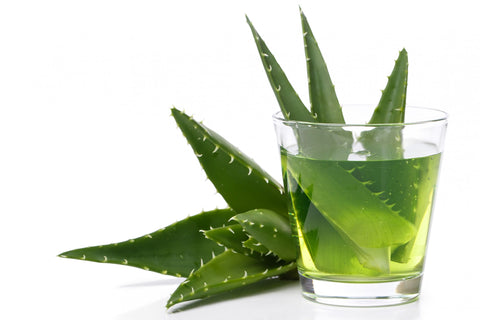The Aloe Vera plant has been known and used for centuries for its health, beauty, medicinal and skin care properties. It belongs to the Liliaceae family, and is a shrubby, perennial and succulent, pea- green colour plant. It grows mainly in the dry regions of Africa, Asia, Europe and America.
Because of the soothing gel inside the thick, succulent leaves, Aloe Vera has incredible, natural, skin care properties and is often called “First Aid” plant. Aloe Vera has been used for medicinal purposes in several cultures for millennia, including Greece, Egypt, India, Mexico, Japan and China. Ancient Chinese and Egyptians used Aloe Vera to treat burns, wounds, and reduce fever.

Active Components of Aloe Vera and Their Properties
Aloe Vera contains 75 potentially active constituents including vitamins, enzymes, minerals, sugars, saponins, salicylic acids and amino acids.
Vitamins: It contains Vitamin A (beta-carotene), C and E. Vitamin A contributes to the maintenance of healthy eyes, skin and hair. Vitamin C has strong immune boosting properties and Vitamin E is well-known antioxidant. Aloe Vera also contains Vitamin B12, Folic Acid, and Choline which contribute to normal energy-yielding metabolism, normal homocysteine and lipid metabolism, and the maintenance of normal liver function (Surjushe et al., 2008).
Enzymes: Aloe Vera contains 8 enzymes such as: aliases, alkaline phosphatase, amylase, bradykinase, carboxypeptidase, catalase, cellulase, lipase, and peroxidase. Bradykinase contributes to the reduction of excessive inflammation when applied to the skin topically, while others assist the body in the breakdown of sugars and fats.
Minerals: It provides Calcium, Chromium, Copper, Selenium, Magnesium, Manganese, Potassium, Sodium and Zinc. These minerals are essential for the proper functioning of various enzyme systems in different metabolic pathways. Chromium is well-known for its ability to regulate blood sugar levels. Calcium contributes to normal blood clotting, muscle & bone function, neurotransmission, and normal functioning of digestive enzymes. Magnesium contributes to normal psychological function, protein synthesis, electrolyte balance, maintenance of normal bones and teeth, and is important in the process of cell division. Manganese is important for the normal functioning of connective tissue and the protection of cells from oxidative stress.
Potassium is important for the maintenance of normal blood pressure. Zinc contributes to normal acid-base and carbohydrate metabolism, normal metabolism of fatty acids and Vitamin A, normal protein synthesis and the maintenance of normal hair, skin and nails.
Sugars: Sugars are derived from the mucilage layer of the plant. Aloe Vera contains monosaccharides (glucose and fructose) and polysaccharides (glucomannans/polymannose). The most predominant monosaccharide is mannose-6-phosphate, and the most common polysaccharides are glucomannans (Surjushe et al., 2008). Recently, a glycoprotein with anti-allergic properties, called alprogen and novel anti-inflammatory compound, C-glucosyl chromone, have also been identified from the Aloe Vera plant (Surjushe et al., 2008).
Anthraquinones: Aloe Vera provides 12 anthraquinones, which are phenolic compounds traditionally known as laxatives. Aloin and Emodin act as analgesics, antibacterials and antivirals.
Fatty acids: Aloe Vera contains 4 plant steroids: cholesterol, campesterol, β-sisosterol and lupeol. All these have anti-inflammatory action; Lupeol also possesses antiseptic and analgesic properties.
Hormones: Aloe Vera is rich in Auxins and gibberellins that contribute to wound healing and have anti-inflammatory properties.
Others: It provides 20 of the 22 human required amino acids and 7 of the 8 essential amino acids. It also contains salicylic acid that is an aspirin like compound possessing anti-inflammatory and antibacterial properties. It has a kerolytic effect which helps to debride a wound of necrotic tissue (Joseph & Raj, 2010). Lignin, an inert substance, when included in topical preparations, enhances penetrative effect of the other ingredients into the skin. Saponins are the soapy substances that form about 3% of the gel and are known for their cleansing and antiseptic properties (Surjushe et al., 2008).
Pharmacological Actions of Aloe Vera
Anti-oxidant activity
Oxidative stress is a result of overproduction of reactive oxygen species (ROS), also known as free radicals. There are a lot of antioxidants that are known to minimize actions of ROS. Phenol compounds can trap the free radicals directly or scavenge them through a series of coupled reactions with antioxidant enzymes (Saritha et al., 2010). Aloe Vera contains various phenolic acids and polyphenols; also, peroxidise and superoxide dismutase enzymes, which contribute to the anti-oxidant effect of this plant.
Wound healing effect
Aloe Vera gel can improve wound healing after topical and systemic administration. When applied topically, Aloe Vera increases synthesis of hyaluronic acid and dermatan sulphate in the granulation tissue of a healing wound (Saritha et al., 2010). After systemic administration, Aloe Vera increases the synthesis of collagen through the mannose-rich polysaccharide content. Glucomannan, a mannose-rich polysaccharide interacts with growth factor receptors on the fibroblast, thereby stimulating its activity and proliferation, which in turn significantly increases collagen synthesis (Hamman, 2008).
Anti-diabetic effect
Aloe Vera is also known to alleviate chronic hyperglycaemia and perturbed lipid profile that are common among people with diabetes, and are major risk factors for cardiovascular complications. In a study done by Yongchaiyudha et al. (1996) blood glucose and serum triglyceride levels were significantly decreased with Aloe Vera treatment. In another study, the effects of Aloe Vera gel or placebo, in combination with glibenclamide (a commonly prescribed antidiabetic medication) were investigated, and presented significant reductions in blood glucose and serum triglyceride levels in the Aloe Vera group (Bunyapraphatsara et al. 1996).
Immune support
The polysaccharides found in Aloe Vera are known to demonstrate immune-modulating activities by affecting antigen presenting cells and the cytokine cascade (Chow et al., 2005). In a study done by Chow et al. (2005), the polysaccharides were found to affect macrophage cells, secretion of cytokines (e.g. tumour necrosis factor-alpha or TNF-α, interleukin-1 or IL-1, interleukin-6 or IL-6 and interferon-γ or INF-γ) and regulation of cell surface markers. Furthermore, the immune protection effect of Aloe Vera was also shown to activate modulating DNA-damage-activated signal transduction pathways; and the glycoprotein Alprogen was shown to demonstrate anti-allergic activity by inhibiting the antigen-antibody-mediated release of histamine (Chow et al., 2005).
Anti-inflammatory effect
Inflammation is a reaction by the body due to injury and is characterised by swelling, pain, redness, heat and loss of function. Aloe gel can reduce inflammation that is induced by agents via promotion of prostaglandin synthesis as well as increased infiltration of leucocytes. In doing that, Aloe Vera inhibits the cyclooxygenase pathway and reduces prostaglandin E2 production from arachidonic acid (Reynolds & Dweck, 1999). The anti-inflammatory effect of Aloe Vera was observed in gastric ulcers. A recent attempt to formally evaluate the efficacy and safety of Aloe Vera gel in the treatment of ulcerative colitis produced encouraging results. In a randomized controlled trial of 44 subjects with mild to moderately active ulcerative colitis, Aloe Vera showed statistically significant improvements in the Aloe Vera group (Foster et al., 2011).
Laxative effect and digestion benefits
Aloe Vera is well-known for its laxative properties. The polyphenolic compounds, anthraquinones, create a potent laxative effect by increasing intestinal water content, stimulating mucus secretion and increasing intestinal peristalsis. In a double-blind, randomized, controlled trial of 28 healthy adults, the laxative effect of Aloe Vera was reported equally potent as the stimulant laxative phenolphthalein (Foster et al., 2011). In regards to its digestive benefits, Aloe Vera helps digestion by normalizing acid/alkaline and pH balance, reducing the risk of yeast formation and encouraging growth of healthy digestive bacteria (probiotics). Aloe Vera has been shown to reduce pain/discomfort of patients with IBS. A study reported by the Journal of Research in Medical Sciences found that 30 ml of Aloe Vera juice twice a day can decrease the level of discomfort in 33 patients with irritable bowel syndrome (Khedmat et al., 2013).
Reference
- Atherton, P. (1997). The essential Aloe Vera: The actions and the evidence. 2nd Ed.
- Bunyapraphatsara, N., Yongchaiyudha, S. et al. (1996). Antidiabetic activity of Aloe Vera juice. Clinical trial in diabetes mellitus patients in combination with glibenclamide. Phytomedicine. 6 (3), 245–248.
- Chow, J., Williamson, D.A. et al. (2005). Chemical characterisation of the immunomodulating polysaccharide of Aloe Vera. Carbohydr. Res. 5 (6), 67-89.
- Foster, M., et al. (2011). Evaluation of the Nutritional and Metabolic Effects of Aloe Vera. Herbal Medicine: Biomolecular and Clinical Aspects. 2nd Edition.
- Hamman, J.H. (2008). Composition and Applications of Aloe Vera Leaf Gel. Molecules. 13 (8), 1599-1616.
- Khedmat, H., Karbasi, A. et al. (2013). Aloe Vera in treatment of refractory irritable bowel syndrome: Trial on Iranian patients. Journal of Research in Medical Sciences. 18 (8), 732-740.
- Reynolds, T., Dweck, A.C. (1999). Aloe Vera leaf gel: a review update. Journal of Ethnopharmacology 68 (9), 33–37.
- Saritha, V., Khanum, F. (2010). Antioxidant and antibacterial activity of Aloe Vera gel extracts. International Journal of Pharmaceutical & Biological Archives. 1 (4), 376-384.
- Surjushe, A., et al. (2008). Aloe Vera: A short review. Indian Journal of Dermatology.53 (4), 163-166.
- Joseph, B., Raj, S.J. (2010). Pharmacognostic and Phytochemical Properties of Aloe Vera: An Overview. International Journal of Pharmaceutical Sciences Review and Research. 4 (2), 10-17.
- Yongchaiyudha, S., Rungpitarangsi, V. et al. (1996). Antidiabetic activity of Aloe Vera. Clinical trial in new cases of diabetes mellitus. Phytomedicine. 6 (3), 241–243.
Any information or product suggested on this website is not intended to diagnose, treat, cure or prevent any medical condition. Never disregard medical advice or delay in seeking it because of something you have read on this website. Consult your primary healthcare physician before using any supplements or making any changes to your regime.





